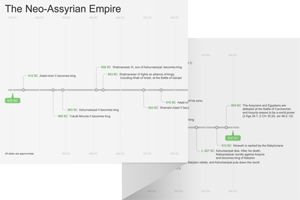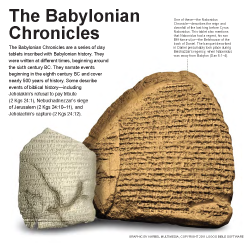2:1–13 This oracle describes a city under attack. In Nah 2:8, the city is revealed to be Nineveh. The language is similar to prophetic descriptions of invaders approaching a city as in Isa 10:28–34. In Isaiah 10, Assyria is God’s instrument of judgment, but Jerusalem is assured that Assyria’s own day of judgment is coming (Isa 10:24–27). Nahum 2 depicts the foretold time when Yahweh’s anger would be directed against Assyria (Isa 10:24–25). (Nahum 2:1–13 corresponds to v. 2–14 in the Hebrew Bible.) |
2:1 Guard the fortification The first of four commands for Nineveh to prepare for battle. The warnings are urgent and terse.
One who shatters has come up against you A reference to the combined army of Babylonians, Medes, and Scythians that eventually conquered Nineveh. The Babylonians routinely scattered (i.e., exiled) prisoners of war to all parts of their empire and transplanted foreigners into conquered territories.
2:2 Yahweh will restore The prophets often use the language of restoration to signal the end of judgment and the imminence of Yahweh’s salvation (see 1:15; Jer 29:14; 30:3, 18; 33:7; Ezek 39:25; Hos 6:11; Joel 3:1; Zeph 2:7).
Jacob A synonym for the people of Israel (see note on Mic 1:5). Israel’s original name was Jacob (see Gen 32:28).
like the majesty of Israel May be comparative (“like the majesty of Israel”) or emphatic (“indeed, the majesty of Israel”).
their branches Refers to Judah metaphorically as a cultivated vine damaged by invaders (compare Psa 80:8–13; Isa 5:1–7).
2:3–10 These verses describe a progression of attack: the offensive force assembles its troops (Nah 2:3), advances towards the city (v. 4), launches an assault (vv. 5–6), takes prisoners (v. 7), and plunders the city (vv. 8–10). |
2:3 The shields of his warriors are dyed red The Babylonians’ shields may have been painted red to strike fear in their enemies. Or, the shields may have gleamed red in the sunlight because of highly polished metal fittings. Alternatively, the prophet may be describing the aftermath of the attack, when shields (and clothing) are dyed red with blood.
the chariots Vehicles of two wheels usually pulled by two horses. Chariots were powerful instruments of war that could dominate battles. In effect, they were the tanks of ancient warfare.
their spears Tall evergreens found throughout the Mediterranean. They often grow in conjunction with cedars and oaks. The polished spears would have a reddish appearance, especially in the sunlight.
2:5 He calls The Hebrew word here is used in the sense of giving orders, a meaning found in the Akkadian cognate.
they stumble as they march The attackers stumble over the city’s defenses or perhaps even over dead bodies (see 3:3).
her wall When Sennacherib, king of Assyria, built the massive walls of Nineveh, he named the outer wall “The Wall That Terrifies the Enemy” and the inner wall “The Wall Whose Splendor Overwhelms the Foe.”
covering The Hebrew word here likely refers to a screen designed to protect those assaulting the city wall from projectiles thrown down from above.
2:6 The gates of the river When ancients built city walls over rivers, they included gates that allowed water (and fish) to continue to flow through the city.
are opened During the siege of Nineveh, a series of torrential downpours swelled the Tigris River and its channels. The city flooded, and the water caused portions of the walls to collapse. These breaches granted the Babylonians access into the city.
the palace May refer to the south palace built by Sennacherib (who reigned 704–681 bc) or the north palace built by Ashurbanipal (the last great king of Assyria, 668–627 bc).
2:8 like a pool of water without its water. As they flee Much of Nineveh lay under water when the city fell (see note on v. 6), but this image of a pool without water describes an empty artificial pool or reservoir. The city will be empty of people just like a reservoir that has been drained.
But there is no one who turns back No one heeds the call to halt the retreat.
2:9 There is no end to the spoils The Babylonian Chronicles Chronicles—which are tablets that record the history of Babylon—state that the amount of treasure in Nineveh was “a quantity beyond counting.” The Assyrians had collected a massive amount of wealth from looting cities like Susa, Babylon, Damascus, Samaria, Memphis, and Thebes.
2:10 All their loins The Hebrew term indicates the area where belts are worn. The prophet may be referring to a feeling of dread in the pit of the stomach or a weakness in the hips that causes a person to collapse.
2:11 Verses 11–12 is a taunt song, a derogatory proverbial chant against an object of scorn and ridicule (e.g., Deut 28:37; Isa 14:4; Jer 24:9; Mic 2:4; Hab 2:6). The taunt mocks Assyria: The once mighty predator of the ancient Near East is now the prey. |
the lions These large, fast, powerful cats are found throughout the ancient Near East. The lion motif is particularly fitting for Assyria; many reliefs discovered on walls and palaces depict Assyrian kings holding lions in their arms or engaging in lion hunts. This verse uses four different Hebrew words for lions.
2:13 I am against you A challenge formula (see note on Ezek 35:3; compare Nah 3:5).
Yahweh of hosts The divine title here is used throughout the prophets (e.g., Isa 1:9; Jer 6:6; Mic 4:4; Hab 2:13; Zeph 2:9; Hag 1: 2; Zech 1:3; Mal 1:4). The title asserts Yahweh’s role as commander-in-chief of the heavenly armies.
fierce lions A reference to Assyria’s warriors—or perhaps, more specifically, its nobles and princes.
I will cut off your prey Assyria will no longer conquer other nations.
messengers will no longer be heard Fulfilled with the fall of Nineveh in 612 bc. See note on Nah 2:1.

|
About Faithlife Study BibleFaithlife Study Bible (FSB) is your guide to the ancient world of the Old and New Testaments, with study notes and articles that draw from a wide range of academic research. FSB helps you learn how to think about interpretation methods and issues so that you can gain a deeper understanding of the text. |
| Copyright |
Copyright 2012 Logos Bible Software. |
| Support Info | fsb |
 Loading…
Loading…



